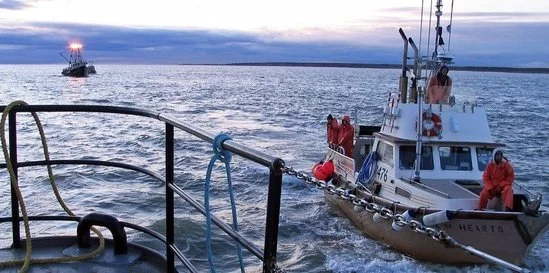While technology changes quickly, the work of modernizing fishery information systems is often slow and steady, and for good reason: big changes in government data programs take resources and time. NMFS’ Fisheries Information System (FIS) program has been a constant driver of deliberate and strategic progress. Because FIS focuses on information needs identified by NMFS staff and data partners, people and organizations outside that network may not know about the program and its positive impacts. From the Net Gains’ Alliance’s perspective, FIS is central to the data modernization improvements of the last decade. As NGA wraps up this phase of our work, we’re writing this love letter to FIS to help others learn from their example and share their stories of how FIS has improved their work.
In the program’s own words, The Fisheries Information System program is a state-regional-federal partnership supporting sound, science-based fisheries management…by fostering collaboration and funding innovative projects. FIS supports multi-partner projects across state and federal entities, at scales from local to national, that would be difficult to fund otherwise. FIS also initiates and staffs communities of practice on key issues, like programming and maintaining data infrastructure. These groups, which they call Professional Specialty Groups, offer places for staff to share tips, improve their skills, and collaborate across projects and teams. These can be important catalysts and lifelines, especially for someone who may be the sole person on a team tasked with maintaining code or improving data workflows.
Just as important as FIS’s focus areas is how FIS operates. FIS sources ideas for its RFPs from the community and evaluates projects against a set of impact metrics, including addressing regional needs, making good use of existing or matching resources, building on previous work, and following best practices with metadata documentation and a data documentation plan.
The FIS program maintains a public library of funded projects, and NGA has written about some of the projects we’ve found especially noteworthy. Our July 2022 report, Communicating the Value of a Data-Driven NMFS, features several examples of FIS projects we think make great anecdotes for communicating about the impacts of data modernization. Our November 2023 report, Data Interoperability: The Slow and Steady Path Forward, highlights several east coast projects that are helping drive progress on data interoperability.
We encourage the FIS program to share more of these stories. From NGA’s perspective there continues to be a need for concise, non-technical stories about the positive impacts of data modernization that can be shared with leadership, the public, and Congress. We also encourage the program to share more information about works in progress through national and regional newsletters, blogs, and social media.
In addition, we think more projects are worthy of being deemed stories worth sharing. In our experience project leads are cautious of describing unfinished work as “success stories,” which is understandable. Realizing the benefits of these projects takes time and testing, and implementation doesn’t always go smoothly - sometimes one solution reveals other underlying technical challenges. Still, we believe the thought process of translating big ideas to smaller steps is valuable and worth sharing. The FIS program can communicate more about ongoing projects, the problems they intend to address, and how. We also recognize that not every project is a success. We encourage FIS to share lessons learned from the projects that don't live up to expectations; for example, perhaps tech doesn’t perform well in the field, or a project exposes other problems that need to be fixed. These are equally important to share.
We also encourage the FIS program to improve the utility of its project database. The database is comprehensive and searchable by region, project lead, and keyword, but it can be time-consuming and clunky to load. It’s not available by an API or downloadable, meaning it can’t be easily integrated with other data sources; for example, if the descriptions and basic attributes were machine readable you could show the location of FIS projects on the regional ocean data portals or OceanReports. The project descriptions are also highly technical, and we suggest including a <300 character description of each project and the problem it aims to address.
As the agency continues to advance its data modernization efforts, including implementing the Federal and NOAA data strategies, undertaking IRA-funded climate-readiness projects, and responding to Congressional calls for improved data and information systems, FIS is poised to play a central role in ensuring that all of these efforts are well coordinated, well defined, and well measured. We hope that FIS will continue its efforts to bring together the many people and projects that keep US fisheries sustainable.

